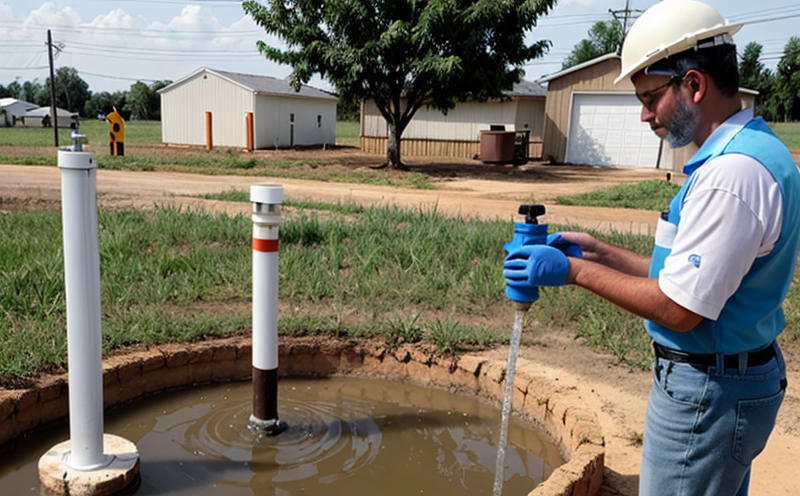EPA Method 200.7 ICP-OES Metals in Groundwater
The EPA Method 200.7 is a widely recognized and stringent procedure for the determination of metals in groundwater samples using Inductively Coupled Plasma Optical Emission Spectrometry (ICP-OES). This method is particularly important for ensuring compliance with environmental regulations aimed at safeguarding public health and protecting ecosystems.
Groundwater quality testing using EPA Method 200.7 is essential for identifying trace metal contamination, which can arise from various sources such as industrial activities, agricultural runoff, and natural weathering of minerals. The method covers a wide range of metals including arsenic (As), cadmium (Cd), chromium (Cr), copper (Cu), lead (Pb), mercury (Hg), nickel (Ni), selenium (Se), silver (Ag), thallium (Tl), and zinc (Zn).
The primary objective of this method is to provide accurate, reliable, and reproducible results that can be used for regulatory compliance purposes. The use of ICP-OES ensures high sensitivity and precision, making it suitable for detecting trace levels of metals in groundwater samples.
Before conducting the analysis, proper sample preparation is crucial. Groundwater samples are typically filtered to remove particulate matter, followed by dilution if necessary. The sample is then introduced into the ICP-OES instrument where it undergoes atomization and excitation processes leading to emission spectra that can be measured.
The method specifies strict quality control measures including spiked replicate analysis (20%) and duplicate analysis (10%), ensuring robust data integrity. Additionally, calibration standards should cover the entire concentration range expected in the sample matrix.
| Sample Preparation | Calibration Standards |
|---|---|
| - Filtering to remove particulate matter | - Covering the entire concentration range of expected metals |
| - Dilution if necessary | - Spiked replicate analysis (20%) |
| - Introducing into ICP-OES for analysis | - Duplicate analysis (10%) |
The results from EPA Method 200.7 are reported in parts per billion (ppb) or micrograms per liter (µg/L). These values provide critical insights into the metal content of groundwater, helping to inform decisions regarding water quality management and remediation efforts.
- Accurate detection of metals at trace levels
- Highly sensitive for environmental monitoring
- Comprehensive coverage of multiple metallic contaminants
The method is validated according to EPA guidelines, ensuring its reliability for regulatory purposes. Compliance with this method is crucial for industries involved in water resource management and public health services.
Benefits
EPA Method 200.7 ICP-OES Metals in Groundwater offers several key benefits, particularly for stakeholders involved in environmental compliance and water quality management:
- Enhanced Compliance: Ensures regulatory standards are met, reducing the risk of non-compliance penalties.
- Precision & Reliability: High accuracy and reproducibility ensure reliable data that can be trusted for decision-making.
- Comprehensive Coverage: The method covers a broad spectrum of metals, providing a complete picture of groundwater quality.
- Cost-Effective: Efficient use of resources through accurate detection, reducing the need for additional sampling and analysis.
The method is designed to meet stringent requirements set by regulatory bodies like the EPA. By adhering to this standard, organizations can demonstrate their commitment to environmental stewardship and public health.
Industry Applications
EPA Method 200.7 is applicable across various industries including:
- Agriculture: Monitoring the impact of fertilizers and pesticides on groundwater.
- Construction: Evaluating potential contamination from construction activities.
- Environmental Management: Assessing water quality in protected areas and natural reserves.
- Pharmaceuticals & Healthcare: Ensuring water used in manufacturing processes meets stringent standards.
The method is particularly useful for industries that are heavily dependent on groundwater resources, as it helps identify potential contamination sources early, allowing for preventive measures to be implemented.
Use Cases and Application Examples
EPA Method 200.7 ICP-OES Metals in Groundwater has numerous practical applications, including:
- Groundwater Monitoring Programs: Continuous monitoring to ensure compliance with regulatory standards.
- Investigation of Contamination Sources: Identifying the origin and extent of metal contamination in groundwater.
- Risk Assessment: Evaluating the potential risk to human health and ecosystems from metals present in groundwater.
| Use Case | Description |
|---|---|
| Groundwater Monitoring Programs | Regular sampling and analysis to ensure compliance with EPA regulations. |
| Investigation of Contamination Sources | Detailed analysis to pinpoint the source and extent of contamination. |
| Risk Assessment | Evaluation of health risks posed by metals in groundwater, informing remediation strategies. |
The method is also valuable for research purposes, enabling scientists to gather data on metal levels over time and under different conditions. This information can be crucial for understanding the natural processes affecting metal concentrations in groundwater.





